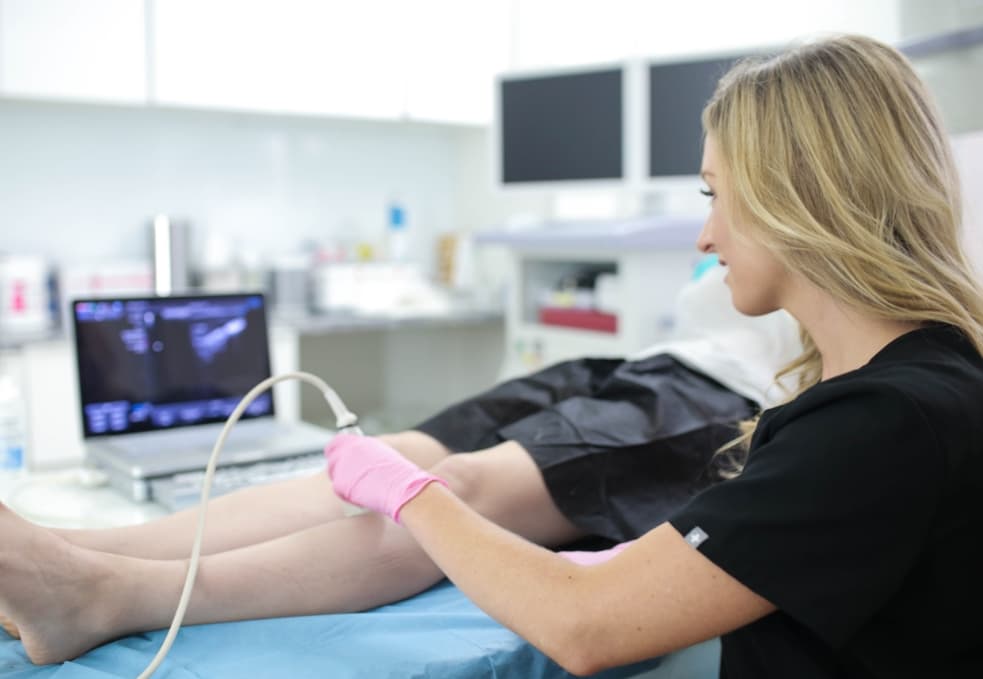What are varicose veins?
Varicose veins are enlarged, twisted veins that most commonly appear in the legs. They occur when the valves in the veins do not work properly, causing the blood to flow in the wrong direction and pool in the veins. This can cause the veins to enlarge and become twisted.
What is the varicose vein stripping procedure?
The varicose vein stripping procedure is a surgical procedure used to remove varicose veins. The surgeon will make a small incision in the skin near the varicose vein. A special instrument, called a vein stripper, is then inserted into the vein and used to pull the vein out through the incision. This is a surgical procedure performed under local anesthesia in hospitals and requires several weeks of recovery.
For these reasons, varicose vein stripping is considered an outdated procedure and only recommended in extreme cases. Most patients can treat varicose veins and underlying vein disease using minimally invasive procedures that conclude within an hour and involve no downtime. Minimally invasive varicose vein treatments, such as vein ablation, are also safer and more effective than vein stripping and other surgical procedures.
Maryland Vein Center is a state-of-the-art vein center specializing in minimally invasive varicose vein treatments. Our vein doctors carefully examine your varicose veins, discuss your symptoms and goals, and curate personalized treatment plans that ensure optimal results without downtime or complications. You can find our vein center in Bethesda, just outside of Washington, D.C., in Silver Spring. Please schedule an appointment at our vein center in Maryland to explore your vein treatment options.

What are the varicose vein stripping steps?
- The first step is to meet with your doctor to discuss whether or not vein stripping is the right treatment for you. Your doctor will need to know about your medical history and any other treatments you have tried in the past.
- Once it is decided that vein stripping is the best course of action, the next step is to schedule the procedure. This is typically done as an outpatient procedure, which means you will be able to go home the same day.
- On the day of the procedure, you will need to arrive at the hospital or surgical center where the procedure will be performed. You will be given a local anesthetic to numb the area around the incisions.
- The next step is to make small incisions in the skin over the varicose veins. Your doctor will then insert a special tool called a stripper, which is used to tie off the veins.
- Once the veins are tied off, they will be removed through the incisions. The incisions will then be closed with stitches or staples.
- You will be given a compression garment to wear after the procedure, which will help to reduce swelling. You will need to wear this for about two weeks.
- Recovery from vein stripping takes a few weeks. During this time, you will need to avoid strenuous activity and keep your legs elevated as much as possible.
What are the potential complications of varicose vein stripping?
As with any surgical procedure, there are potential complications of varicose vein stripping. These complications include:
- Bleeding
- Infection
- Blood clots
- Nerve damage
- Scarring
- Pain
- Swelling
- Bruising
- Skin ulcers
What is the recovery time for varicose vein stripping?
Most people are able to return to their normal activities within a week after the procedure. However, it is important to avoid strenuous activity for at least four weeks after the procedure. Your surgeon will let you know when it is safe to return to your normal activity level.
Varicose vein stripping vs. vein ablation: what’s better?
The two most common treatments for varicose veins are vein stripping and endovenous ablation, but what’s the difference? And, more importantly, which one is better?
Vein stripping is a surgical procedure in which the affected veins are removed through a small incision. Endovenous ablation is a minimally-invasive procedure that uses heat to seal the affected veins. There are a few key differences between these two procedures:
- Vein stripping is a more invasive procedure. It requires incisions and usually takes about an hour to complete. Endovenous ablation is much less invasive. The procedure is typically done in under an hour and only requires a small needle.
- Vein stripping has a longer recovery time. You can expect to take 2-4 weeks off from work or other activities. Endovenous ablation has a much shorter recovery time. Most people can return to work immediately after the treatment.
- Vein stripping may be suitable for extremely large and tortuous varicose veins. Endovenous ablation is just as effective for smaller veins and can treat the root cause of vein problems.
- Vein stripping carries a risk of complications, such as infection, blood clots, and nerve damage. Endovenous ablation has a very low risk of complications.
Endovenous ablation is the better choice for most people. It is less invasive, has a shorter recovery time, and carries a lower risk of complications. That’s why you should only look for vein doctors specializing in minimally invasive spider vein and varicose vein treatments instead of vascular surgery.
Advantages of minimally invasive vein treatments over vascular surgery:
There are several advantages of minimally invasive vein treatments over conventional vascular surgery. The most obvious benefit is that minimally invasive procedures are much less invasive than conventional surgery. This means that patients undergoing minimally invasive procedures experience less pain, bleeding, and scarring. In addition, minimally invasive procedures often have a shorter recovery time than conventional surgery.
Another advantage of minimally invasive vein treatments is that they are often less expensive than conventional surgery. This is because minimally invasive procedures often require less time in the operating room and less post-operative care. In addition, minimally invasive procedures are often performed on an outpatient basis, which further reduces costs.
Finally, minimally invasive vein treatments offer patients a number of aesthetic benefits. Because minimally invasive procedures result in less scarring, patients can often choose to have their procedures performed in less visible areas. In addition, the shorter recovery time associated with minimally invasive procedures means that patients can often return to their normal activities sooner.





